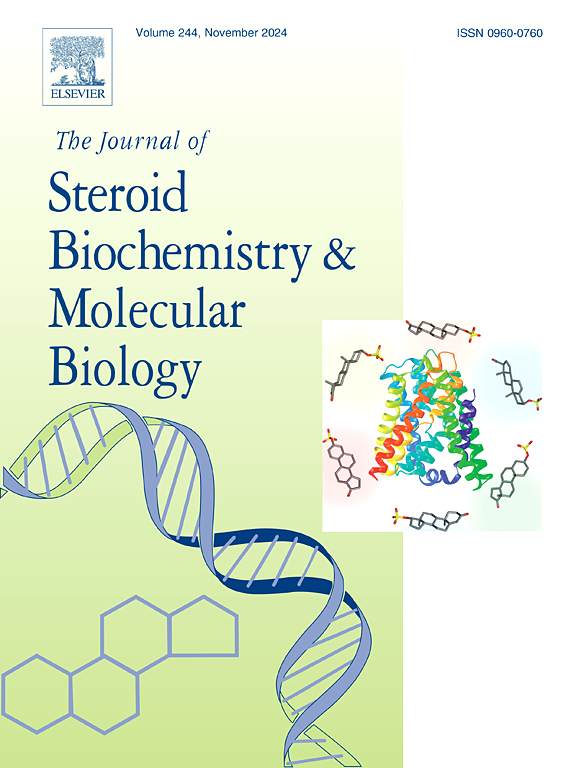Changes in vitamin D biomarkers across pregnancy and by maternal BMI: A secondary analysis of data and biospecimens from the National Children’s Study
IF 2.5
2区 生物学
Q3 BIOCHEMISTRY & MOLECULAR BIOLOGY
Journal of Steroid Biochemistry and Molecular Biology
Pub Date : 2025-05-21
DOI:10.1016/j.jsbmb.2025.106791
引用次数: 0
Abstract
Obesity during pregnancy is associated with increased risk for vitamin D deficiency in both the mother and offspring. Free or unbound 25-hydroxyvitamin D (25(OH)D) is the biologically active form as compared to total 25(OH)D, which may be important in the assessment of vitamin D status during conditions like pregnancy where vitamin D binding protein (VDBP) is affected. Little is known about how pre-pregnancy BMI affects changes in vitamin D markers during pregnancy. This is a secondary analysis of data and biospecimens from the 2009–2014 National Children’s Study (NCS). The current analysis included 50 participants (50 % normal weight [18.5 ≥BMI<25 kg/m2] and 50 % overweight/obese [BMI≥25 kg/m2]), recruited across four US Census regions (Northeast, South, West, and Midwest), with serum samples available from three time points during pregnancy: 1st half (<25 weeks), 2nd half (>25 weeks) and birth. Total 25(OH)D was quantified via liquid chromatography-tandem mass spectrometry (LC-MS/MS), and commercially available assays were used to measure free 25(OH)D and VDBP. Percent free 25(OH)D was calculated as . Linear mixed effect models, including quadratic gestational age term were employed to exam the change in vitamin D metabolites by quadratic gestational age, as well as interactions with pre-pregnancy BMI and season of birth. A positive linear trend was observed for total 25(OH)D levels across gestation (p = 0.002), while quadratic relationships were observed for both VDBP (p < 0.001) and % free 25(OH)D (p = 0.001). A significant interaction was observed between gestational age and season of birth for total 25(OH)D (p < 0.001) and free 25(OH)D (p = 0.006). Furthermore, the interactive effect of gestational age and pre-pregnancy BMI was statistically significant for both total 25(OH)D (p = 0.002) and % free 25(OH)D (p = 0.007). Our results suggest that among a sample of US women both season of birth and maternal pre-pregnancy BMI affected changes in vitamin D metabolites across pregnancy. The effects of maternal BMI on changes in total 25(OH)D and % free 25(OH)D across pregnancy suggest maternal obesity may differentially affect vitamin D metabolism in pregnancy. Future research is necessary to compare differences in vitamin D metabolism among obesity affected pregnancies as compared to healthy-weight counterparts.
维生素D生物标志物在怀孕期间和母亲BMI的变化:对国家儿童研究数据和生物标本的二次分析。
怀孕期间的肥胖与母亲和后代维生素D缺乏的风险增加有关。游离或未结合的25-羟基维生素D (25(OH)D)是与总25(OH)D相比具有生物活性的形式,这对于在维生素D结合蛋白(VDBP)受到影响的怀孕期间评估维生素D状态可能很重要。对于怀孕前的身体质量指数如何影响怀孕期间维生素D指标的变化,人们知之甚少。这是对2009-2014年国家儿童研究(NCS)数据和生物标本的二次分析。目前的分析包括50名参与者(50%正常体重[18.5≥BMI2]和50%超重/肥胖[BMI≥25kg/m2]),来自美国四个人口普查地区(东北部,南部,西部和中西部),在怀孕期间的三个时间点提供血清样本:前半期(和一半(bb0 - 25周)和出生。总25(OH)D采用液相色谱-串联质谱(LC-MS/MS)定量,游离25(OH)D和VDBP采用市售测定法测定。游离25(OH)D百分比计算为free25OHDtotal25OHDx100。采用线性混合效应模型,包括二次胎龄项来检验维生素D代谢物随二次胎龄的变化,以及与孕前BMI和出生季节的相互作用。总25(OH)D水平在整个妊娠期间呈线性正相关(p=0.002),而VDBP和VDBP均呈二次关系(p=0.002)
本文章由计算机程序翻译,如有差异,请以英文原文为准。
求助全文
约1分钟内获得全文
求助全文
来源期刊
CiteScore
8.60
自引率
2.40%
发文量
113
审稿时长
46 days
期刊介绍:
The Journal of Steroid Biochemistry and Molecular Biology is devoted to new experimental and theoretical developments in areas related to steroids including vitamin D, lipids and their metabolomics. The Journal publishes a variety of contributions, including original articles, general and focused reviews, and rapid communications (brief articles of particular interest and clear novelty). Selected cutting-edge topics will be addressed in Special Issues managed by Guest Editors. Special Issues will contain both commissioned reviews and original research papers to provide comprehensive coverage of specific topics, and all submissions will undergo rigorous peer-review prior to publication.

 求助内容:
求助内容: 应助结果提醒方式:
应助结果提醒方式:


